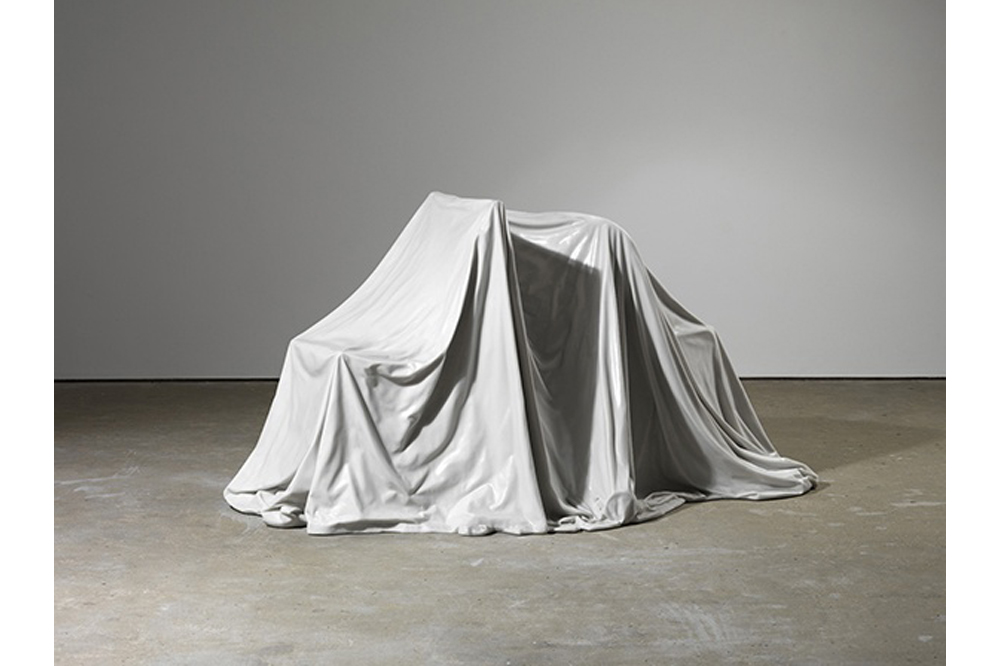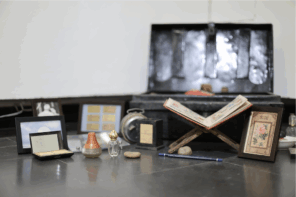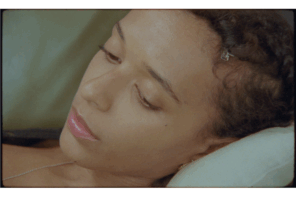At the end of our interview Ryan Gander is suggesting we meet again, “Same time next week?” He’s laughing. I’ve involuntarily submitted myself to the role of councilor, it seems, and he plays this out with commitment, performing the role of defeated artist in need of cheering (the subject of “kids these days” is causing him some disconcertion, though he’s self-conscious of sounding like “a miserable old git”). Old is hardly the word for Gander (he turns 40 this spring). Rather, thoughtful, nimble, shape-shifting, erudite, impatient, quick-witted, contradictory, and critical would do; and, of course, deeply disinterested in trends. But Gander’s discontent (with Post-Internet art, with silver-spoon art stars, with faddish cultural movements feigning self-seriousness) isn’t evidenced in his practice, one tagged with Conceptualism, performance, and, at turns, narrative and abstraction. If there’s a long-hewn brown study at work in his practice – a brooding or a melancholy – it’s more likely linked to the question of concealment. What do we choose to reveal and what should we cloak in a world so leaden with information, and for an audience so tacitly accustomed to passively scrolling and parsing?
These are essentializing questions, but critical for an artist so liquid in his formation. Skipping stones across the surface of contemporary art history, regularly humid with his citations, and then airborne again (Art in America recently termed him “a ludic, style-hopping fleecer-pasticher of Conceptual art strategies”), Gander’s practice drills down to two kinds of works: there are those that reveal and those that conceal (when I mention this he assures me that he’s stealing this dichotomy for the title of his next work). In addition to a residency at OCAD University, and a forthcoming exhibition at the Musée d’art contemporain de Montréal, Gander is visiting Canada to open a new exhibition at Scrap Metal, a large Toronto exhibition space that stems from (or informs) the collection of Samara Walbohm and Joe Shlesinger. The spare show features both kinds of work, for instance a fort made of marble (from his well-toured I is … series), and a wooden, four-plane podium hosting a series of images, as presented by a performed artist. Both navigate their indexicalities, hovering between familiarity and obfuscation, surface and depth. The choice to cloak or reveal is a decision that dogs him.
Scrap Metal curator Rui Amaral and founding collector Samara Walbohm both told me that you felt, upon seeing your exhibition, that the work didn’t feel like your own. Could you reflect on what you meant by that?
I think with art you have the works that are maybe like words, and then shows that are like sentences, and then your practice is a bit like a novel. And the more fluent and articulate you become in visual language, the easier the words come. So making a work isn’t such a big deal; it’s enjoyable and you’re determined to make it but it’s not really difficult. [Because] with mental agility you just become very … it comes very naturally after a while. Making exhibitions, however, becomes massively interesting, and especially if you’re prolific and you have a diverse practice with lots of different accents and types of works, ’cause then it’s a bit like self-curating your own group show. So it’s like a whole new mode of creativity opens up when you have this archive of works to choose from.
And there’s the big thing that’s the trajectory of practice over a long time which is a thing I’m really interested in. Like, I base all artists’ success on that, really, the bigger picture. It’s better to be a sort of productive failure than an unproductive success.
Do you get self-conscious about that larger trajectory? Do you ever sort of halt as you’re considering what you’re producing in terms of legacy and the larger oeuvre?
I’m always so proud that I don’t really have a style, and then, whenever I’ve said that, people say, “Oh, but you do have a style, you have a non-style.” Someone walks into a show or a fair, and they see something and they can’t place it; they say, “Oh, that Ryan Gander made it, because he’s always trying to do something different.” [Laughs] And that’s not something I’m ashamed of, I really like that. It sounds like a dis but for me, it’s being complimentary, because that’s my objective, to remain light on my feet and jump about and try things, and make a lot of rubbish and throw it out, and discover it. I’m never sitting around feeling bored or feeling stuck, because life is just one massive creative act anyway.
You have a constellation of concerns and motifs in your practice. How conscientiously are you thinking about how they relate to one another or which one you’re approaching at a given moment?
It’s learned behavior. Yeah, I’ve learned a strategy to do it. Usually it’s a process of elimination. It’s listing objectives, listing assumptions, taking away everything that doesn’t fit, narrowing it down. And it depends on context and even if, you know, if it’s a public commission for a bank in Paris, or a public commission for a bank in Rome, they’re very different. Even if it’s the same building, identical buildings. So it’s just all that stuff that I’ve learned every time I guess.
Yes.
I mean, I was trying to explain to my mum that visual language is like a real language and if I spent twenty years learning Russian I’d probably be quite fluent at Russian. But you can’t quantify visual language so she can’t ever test how fluent I am in visual language, but I try to say “Mum, I can speak visual language really well now.” [Laughs]
I like that term, “visual language,” and I think it has a bit more traction than “Conceptual art,” on some level. How do you respond to Conceptual art in relation to your practice?
People refer to me sometimes as a Conceptual artist or a neo-Conceptual artist. And Lisson Gallery, the gallery that I have in America and Italy and London, they’re traditionally a gallery for Conceptual artists, but my work isn’t Conceptual art; I mean, I guess it’s related to Conceptual art because I don’t care about the physicality of the object. I mean, the object is only important to me to tell the story or to be a vessel or a byproduct or a receipt of the story, and the learned behavior of an artist or that fluency of visual language is just knowing what to do with that object to be able to acutely put the spectator in a place where they start thinking around something you don’t normally think around. But if the story can be carried on the wind you don’t need an object, it’s not that important; it just represents the story. I mean, that’s how it’s nearly Conceptual art. But traditionally Conceptual art doesn’t have guilt, or love, or humor or nostalgia or all the poetic emotions which, I think I’d be bragging if I said my work has, but I’ve tried to encourage them. I suppose [my work] must have them because it’s all in me? And it’s all a byproduct of me. So, it must be humor and romance. [Adopts a self-mocking voice] Humor and romance! [Laughs]
On this note, there’s a word that crops up a couple of times in the readings I’ve done around you, one of which is solipsism.
Which one?
Solipsism?
I don’t know this word.
Well, it can mean … traditionally, it’s used pejoratively to suggest navel-gazing or internal engagement to an exclusive degree. Having said that, I don’t know that it’s being used pejoratively in your case. But I wonder how you navigate a regard for your own romantic feeling, your emotive state, and personal narrative, with the responsibilities to a public that these things be legible?
The public will always get something different from it anyway. There’s big stories in the work that people should get anyway just from looking at the title, or just being human, whether they’re profoundly intelligent or not, there’s those themes. But then there’s also the finer stories, the catalysts for me to make them, in a way; they’re my reasoning for making them. And you shouldn’t underestimate the currencies of communication in art. Cause it’s not just the “thing” that’s the artwork, it’s the thing in its context and the way that it’s positioned — in the whole institution of art and in a gallery or a museum, and then there’s the title. And then there’s me talking to you recording it and people reading it, and then there’s the gossip. I mean, if an artist spends all that time thinking about what art works are like, I think that’s quite naive.
What do you mean when you say “what art works are like”?
Well, the way Gilbert and George dress, and the way they walk to the same restaurant every day, and they have this very repetitive lifestyle. And the way that they have their suits tailored, and they’re a gay couple, that’s like, their work. And if you didn’t know that about them and you only saw their work, the “work” would only be what you know of that work. And similarly with Panamarenko pretending to be an inventor, or Atelier van Lieshout pretending to own a huge business, or Tracey Emin being just profoundly irritating, or … all these artists’ identities. I don’t use my own identity in my work, per se. That’s not something I’m massively interested in. I think it narrows down your options rather than opens them up.
And I think that identity is a tricky word; I’m not sure that’s what we’re really talking about. But personal experience or narrative, then that’s material, that’s grist to the mill.
Yeah, yeah. I don’t know. When spectators talk about the work being elite or “inaccessible,” my reply is that accessibility is massively overrated. And I’d never enjoy a work that was handed to me on a silver platter with an answer or a singular meaning. And the work’s value’s in the individual’s ability to discover it, and to invest their energy in reading about the artist, and their whole practice, and the massive trajectory of their practice. And if someone comes up to a work and expects a three-second burst and just wants it to flash and beep in big in a million different colors, then you should just go watch the new Bond movie or something, and not be in an art gallery. Because it’s not entertainment, it’s not even in the same public sector as entertainment. [Laughs] It’s in the sector of knowledge, which is different … It’s inaccessible.
Right.
But I think medical science is inaccessible too. I never go to a doctor and say “hey doc, can you drill in my right temple because I have a headache?” because he is a brain surgeon and he knows more than me. So likewise everybody thinks they know more about visual language and contemporary art, even if they haven’t spent twenty years going on about it. That’s what I would say.
I’m heartened to hear that opinion reflected back to me.
But I also think it’s like, when you think about it, the artworld is the same size as Formula One car racing, or the world of watches and expensive time pieces. So there are those trade fairs that are just like art fairs and these people that fly around the world doing these things, and there are expensive products, and there are the hierarchies and stratification. And these worlds are all exactly the same, with the same amount of people, with the same amount of money. But the difference is that everybody thinks that art is like religion, and that it should be accessible to them. But not everybody thinks they should appreciate watches, and not everybody enjoys Formula One racing.
It’s a specialization, right.
It’s very bizarre to me, that.
It’s curious to hear you say this, though, because there are moments when you invite your audience into a backstory, and then there are moments when you’re reflecting on obfuscation itself, the very modem by which we can’t see through. So how do you choose when you’re going to signal to something like a rabbit hole, and when you’re going to “bury the hole” for your audience?
God, that’s a good question. When do you signify the rabbit hole and when do you bury it … Um, it depends on what the work is, because some works need to be more accessible, and some works need to be codified, because they’re too accessible. I think that a lot of the enjoyment of art, or the excess of art, I think about the approachability of it and the time it takes for you to get the artwork and then the duration of time that the artwork stays with you after you’ve seen it. And so it’s making it more accessible or less accessible to get those durations right, in a way.
Right.
So it needs to have a – I mean, it’s hard to talk about it like this because it’s not the same for all work – there needs to be an air of intrigue, like the human instinct, innate, so you’re drawn to it. And then there needs to be a conundrum, somehow. There needs to be some body candy, or brain candy, or eye candy, so you’re drawn in. But the brain candy is the not understanding it, not being able to position it in the world. Not being able to answer one of the questions about its authorship, ownership, cost value, worth, these inherent qualities that every object has. There has to be a missing question there. And then it doesn’t matter if it looks good or if it looks bad or you like it or you don’t like it, or you think it isn’t good art made by a bad artist, because you’ll be on your way to work on the bus the next day and you’ll still be thinking about it, even if you hated it, because it’s a good artwork. See I’d never hang a really good artwork in my house, probably. Because it wouldn’t be easy to look good enough to live with every day.
You’re not talking about your own artwork, I assume, you’re talking about work in general?
All work.
That’s an interesting thing to say.
I mean, the work I have in my house looks good in that it represents some kind of belief system about creativity. They’re like totems of high culture. Like every signifier of every piece of furniture in everyone’s house and all the clothes that everyone wears is a signifier of who they think they are and who they want to be. It’s just the same, but art isn’t that. The problem lately is that at the moment all art is that. You go to an art fair and there’s a lot of “validation through association.” Artists who quote things but have no understanding. Modernism in general is a great one.
This leads me to something I wanted to ask you about, a work in your current show at Scrap Metal, Barrágan’s Device, 1988 by Abbé Faria (2011). There’s an indexical quality to that piece, of course, and I know you’ve talked about this device in terms of “spastic association,” and I can see an earnest appeal to your audience to make those connections for themselves. But don’t you run the risk, especially at this point in contemporary literacy, of having the very gesture to indexicality be flattened out as exactly that, a gesture to indexicality?
It’s the whole problem of the “scroll generation.” So it’s a question of how lazy the spectator is. If you stop at, “oh it’s postmodern, it’s a load of images, and we’re meant to make associations between them,” if you stop there, then you should be looking at Instagram. Not in a gallery, I guess. But the work is more talking about the way that agile minds or creative thinkers use tools to restructure information in their head.
There’s a lot of intimacy in your more autobiographical work. Is there ever an intimacy that feels too vulnerable for your audience?
You know what, there isn’t. Which I’d never thought … it’s really weird. I have two studios, one in the country where I go on my own. And [regarding that one] there’s always the question, “is that where you go to do the things that are embarrassing?” But I understand the value of the embarrassing things. I don’t trust super-human artists who make good work all the time. It’s good for other people who look at art or want to make art, to see that you make shit stuff. The mistakes. You learn more from all the stuff you throw out than the stuff that goes away for exhibitions. And there’s also some stuff you make to get out of the studio, and some stuff to get out of yourself. There’s a big difference between these things. Or get off the list, it’s been on the list too long.
Right. Set ’em up, knock ’em down.
Yes.
Now more than ever I think it’s important to be thoughtful about what we cover and what we reveal. As the world is given over to us in all its tonnage right now, are you being more thoughtful about how you make that decision?
God. I think the role of art will become … I’m not a forecaster or anything but I’m guessing we’ll probably see more and more art that allows you to do things that you can’t do within the conformity of society. So I’ve always had this work in my notebooks that’s a house in a rich part of town where the key’s under the mat. And that’s the artwork. You get told that there’s a key under the mat, and you get to decide whether or not to go there. You can go there and let yourself in and wander around someone’s house but not knowing whether you’re breaking or entering or not. There’s something in that that’s kind of experiential … Or like an artwork that’s a hotel room where you stay the night. I feel like there’s a real unexplored value in that area. Being other people. It’s a bit like Total Recall, do you know what I mean? Going into a virtual reality and being someone else, like a spy. Maybe that’ll become something.
Or we’re seeing this massive slowness, this slow culture.
Are we?
Beards, coffee, people of leather –
[Laughs]
– linen, goose down, all these slow things that will last forever and won’t wear out. Foraging for food, what’s that? Last year there was a massive amnesty of social media at New Year’s Eve, there’s record numbers of people dumping their Instagram and Facebook accounts. Huge New Year’s resolutions by people just saying “I’m not doing it.”
Yeah, but we’ll see where they’re at come May.
[Laughs]I liken that to the Pre-Raphaelites or something, this pushing back against the speed of culture. But it’s ultimately marginalia.
Yeah, this is just the people wearing ponchos.
This is the problem with good art. That everyone wants everything very fast. I mean at least in London. Maybe I should just stay out of London. These quick-hit references, emojis.
Yeah but the market isn’t what sticks around.
This is good, there you go again, like a counselor, calming me down. Same time next week?

























